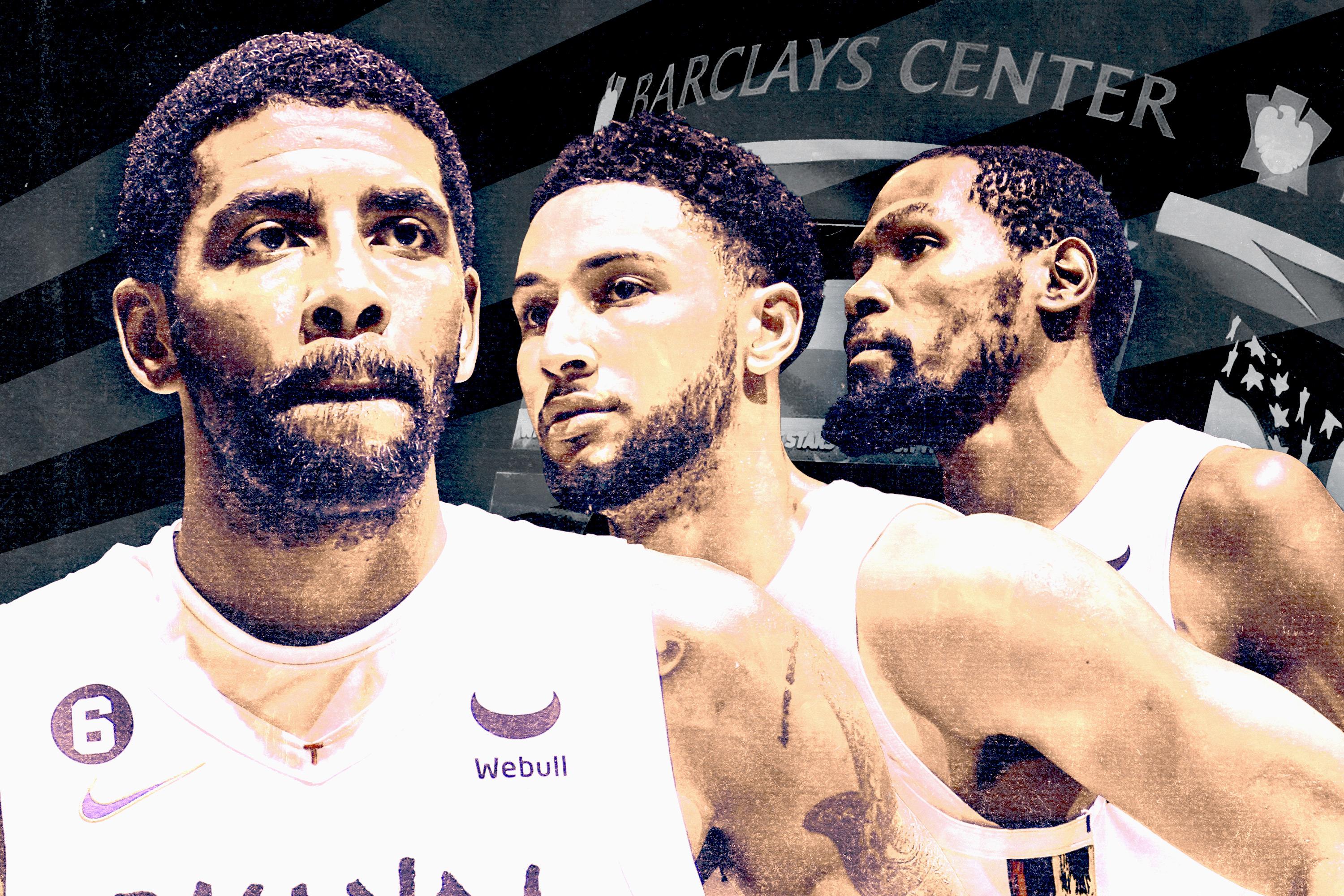
For better and (certainly) for worse, the Brooklyn Nets do not lack tension. Here are a few things that happened to them since Kyrie Irving was suspended on November 3:
- Kevin Durant gave an interview to Bleacher Report’s Chris Haynes in which, among many other things, he said: “Look at our starting lineup. Edmond Sumner, Royce O’Neale, Joe Harris, Claxton, and me. It’s not disrespect, but what are you expecting from that group? You expect us to win because I’m out there. So if you’re watching from that lens, you’re expecting us to play well because No. 7 is out there.”
- A report emerged from The Athletic about the rocky relationship between Ben Simmons and his teammates. It included details about Brooklyn’s infamous players-only meeting on October 29, wherein Markieff Morris “spoke up in front of all of his teammates about how they need Simmons to succeed and that he has to respond when he deals with adversity on the court.”
- After back-to-back losses against the Lakers and Kings, Nets head coach Jacque Vaughn gave one of the best quotes in recent NBA history: “I don’t know if our minds, our bodies, and souls are still in L.A. L.A. can do that to you sometimes.” (Brooklyn allowed 153 points in Sacramento.)
On Sunday night, Irving returned to action after serving an eight-game suspension for sharing a video with antisemitic tropes and then refusing to apologize or denounce its anti-Jewish language in public. Both Durant and Simmons were also in the lineup. Almost all was right at Barclays Center for the first time in a long time. The Nets scored 70 points in the second half and proceeded to beat the short-handed Grizzlies by 12 points. Wins are always good, but this one might be the first of Brooklyn’s season that sparks something deeper than just relief.
For a team that is desperate to put the most embarrassing episode in its history behind it, the victory is a potential (I repeat: potential) turning point. An actual sense of optimism may be taking hold.
Now on the verge of settling into some sense of normalcy, two questions matter: (1) What are the Nets? (2) Where do they go from here? A few weeks ago this team was an embarrassment. Now healthy, with a new head coach leading a resuscitated roster, there are actual reasons to feel optimistic about this group, distractions aside.
While Irving was suspended, the Nets went 5-3, ranked second in defensive rating, third in net rating, and fourth in assist percentage. With him back on the floor, Ben Simmons is starting to look more assertive and to positively impact both ends (just in time for Tuesday night’s trip to Philadelphia!); Kevin Durant is still Kevin Durant; important role players like Joe Harris and Seth Curry are rounding into form; and Yuta Watanabe has turned into the hottest shooter on the planet.
There are also reasons to feel like the Nets could implode at any moment. The team has a core personality trait that can best be described as erratic. Time will tell whether they have enough shot making and discipline to overcome, well, themselves.
Big-picture questions loom. Durant may grow frustrated with Brooklyn’s inconsistency and demand another trade before the deadline. There are 184 players who’ve taken at least 100 shots and none have a higher heavy contest rate than KD. His job is difficult, and if the Nets backslide there are some fascinating scenarios to consider even if few are likely to happen. My personal favorite ships Durant to the Blazers for Anfernee Simons—who can’t be traded until January 15—Jerami Grant, three unprotected first-round picks, and a couple of pick swaps. (Portland would have to modify the protection on the 2023 pick it owes the Bulls to make this work.)
A trade request would upend the Nets and alter the whole league’s complexion. But if Durant recommits himself to the organization and Irving avoids peddling hate speech for the next few months, Brooklyn’s only on-court variable will be Simmons, who’s making a slow return back to the singular two-way force Sean Marks assumed he was getting in the James Harden trade.
On Sunday, Simmons was back in the starting lineup as a wrecking-ball point center. He attacked the paint, rolled hard off screens, got to his spots in the post, crashed the glass, found open teammates, and put together his best end-to-end basketball game since Round 1 of the 2021 playoffs: 22 points (on 13 shots), eight rebounds, and five assists. When Simmons accentuates his own power by leveraging his teammates’ gravity and all the space it provides, very good things happen.
Simmons downplayed his performance afterward, reiterating that he has always believed he’d get back to who he was. His teammates agreed. “I expect this from Ben,” Durant said. “So when he play well I’m not gonna get excited about it.” In reality, this was a huge deal for a team that can’t accomplish anything meaningful without him. It’s also coming off another night that’s worth remembering.
The most pivotal moment of Simmons’s season, though, might’ve happened on Thursday when he wasn’t even on the court. A couple of minutes into the third quarter of Brooklyn’s tight win against the Blazers, Sumner lost track of Damian Lillard trying to dodge a thicket of screens and it led to an open Simons 3.
Vaughn replaced Sumner with Simmons at the next dead ball, slotting him next to the rest of the team’s starters, and it’s not hyperbole to wonder whether that decision will be seen as a watershed moment for the Nets and Simmons when we look back at it three months from now.
Simmons played 19 minutes during the second half—a total topped only by Durant—and had a higher plus/minus than everyone else in the game. He set smart screens, rebounded, competed on defense, ran effective fast breaks (the Nets are way more likely to run off an opposing missed shot when he’s on the court), and even rolled into an aggressive duck-in. It’s too soon to know whether this is a return to form. Simmons doesn’t look quite like a max player yet, but he seems to be finally realizing he’s bigger and faster than 95 percent of the league:
In Simmons’s first five games back from knee soreness, Vaughn brought him off the bench to experiment with different looks, including fun, tiny lineups that featured him at the 5 surrounded by some of the best shooters alive. Those groups aren’t sustainable on the defensive end, but swap in Durant and Watanabe (who’s producing an absurd 1.58 points per shot) for, say, Curry and Patty Mills, and suddenly there’s more size without sacrificing any space. (The Simmons-Durant-Watanabe-O’Neale-Harris lineup has played only four minutes this season.)
Defensively, Simmons can be Brooklyn’s own Bam Adebayo, a physical, positionless monster who switches just about every screen he’s involved in. The Nets can either put him on the opponent’s top offensive option or neutralize the action by sticking him on whoever’s most likely to set a ball screen.
But the original issues that made Simmons a polarizing player before he got to Brooklyn—an allergic reaction to jump shots and a weary relationship with the free throw line—still exist. He can’t share the floor with teammates who don’t shoot, which restricts lineup possibilities and, more specifically, forces Vaughn to either stagger Simmons and Nic Claxton (who missed Sunday’s game due to personal reasons) or find ways to juice the offense with both on the court. There are some possessions when Brooklyn’s sheer talent will mitigate the issue, but even someone like Durant can’t consistently overcome a cramped floor.
And then there’s Simmons’s free throw shooting, a fatal flaw that opponents are beginning to pick at once again. Simmons didn’t attempt a single free throw in his first three games back, and Blazers head coach Chauncey Billups chose to intentionally foul him twice in crunch time on Thursday.
The Nets should be thrilled with what they’ve recently seen from several important players, including Simmons and Watanabe. They also have reason to believe their offense will be even better than it’s already been: They rank first in quantified shot probability and 25th in quantified shot making. A lot of that is thanks to uncharacteristically low 3-point percentages from Joe Harris, Durant, and Irving. Those should tick up, especially if Simmons keeps setting them up with wide-open looks in transition.
Granted, it was against an opponent that was missing what’s been the NBA’s best backcourt, but everything clicked for the Nets on Sunday. They logged a season-high 33 assists and shot a season-high 60.2 percent from the floor. There’s still a lot of basketball to be played and it’s impossible to trust this team until it spends a few more weeks looking like it did against Memphis.
But if Simmons, Durant, and Irving find a way to complement one another, and if they’re supported by a cast that was initially constructed to make their lives easier, Brooklyn can actually resemble a playoff team, if not something more.

